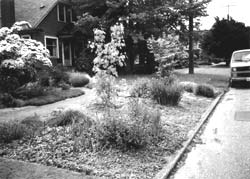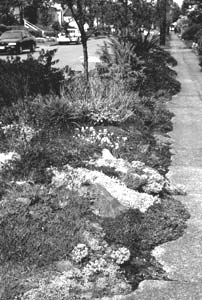Curbside Gardens—Transforming Your Hell Strip
One summer evening, I glanced out the window to see a young couple and their daughter taking a stroll along my Seattle street. The sun's slanting rays illuminated the toddler as she left the sidewalk to explore my curbside planting strip. She walked along the stone pathway, stopped to touch the fuzzy blooms of Mexican bush salvia (Salvia leucantha), climbed onto the kid-sized boulder, and jumped delightedly into her father's arms.
This enchanting scene would not have taken place a few years ago. Back then, the planting strip contained three nondescript trees and a sorry expanse of lawn. Often full of dandelions, its ragged edges spilled over onto the sidewalk. Its turfgrass turned brown for lack of water; like most planting strips, mine was as dry as the Sahara by midsummer without supplemental irrigation.
Heated by pavement, often assaulted by salt and sand during winter, these ribbons of city-owned real estate are not prime gardening spots. Indeed, they have been dubbed "hell strips" by writer Lauren Springer. My own hell strip finally died a merciful death one autumn when I had the trees removed and took a shovel to the turf.
That first rainy winter, the strip was not a pretty sight. Two spindly trees inside tomato cages, some dormant perennials, and a scattering of coastal strawberry plants (Fragaria chiloensis) sat forlornly alongside one another. To keep the soil in place, I mulched with dead leaves.
Timely Transformations

The author's curbside garden (Photo: Claire Hagen Dole)
It didn't take long for the wild strawberries to spread into a tough groundcover, as they are impervious to light foot traffic and evergreen in Northwest winters. Creeping thyme (Thymus praecox ssp. arcticus) and tiny sedums (Sedum species) now soften the edges of the two stone pathways. In spring, dark-blue Siberian iris (Iris sibirica) and bugle (Ajuga reptans) contrast with the yellow of dainty species tulips (Tulipa linifolia f. chrysantha). Moss phlox (Phlox subulata) nestles by the fieldstone rock, its needle-like foliage covered with pink blossoms.
The Japanese maple (Acer palmatum) and Rocky Mountain maple (A. glabrum) that I planted are quickly growing to a respectable size but will not overtake the wires above. In non-drought years, they manage nicely on Seattle's rainfall alone, and their leaves provide a glorious blaze of fall color. In winter, the strip has a pleasing spare look, with tidy ground-cover and interesting flower heads and seedpods.
The strip comes into full glory from early summer through fall, when showy flowers and herbs attract songbirds, butterflies, bumblebees, and other pollinators. When deadheaded, the deep-red bugles of penstemon (P. campanulatus) persist for months, mingling with Northwest natives such as sulphur flower (Eriogonum umbellatum), pearly everlasting (Anaphalis margaritacea), Douglas aster (Aster subspicatus), and columbine (Aquilegia formosa). At one end of the strip, off-limits to sprawling strawberries, grow a variety of herbs. Pine-needle mulch keeps the soil soft and weed-free.
Gardening Jurisprudence

Photo: Claire Hagen Dole
In garden-happy Seattle, such curbside landscapes have become popular, and some are quite imaginative, sculpted into curving mounds and walkways, with exuberant displays of flowers, herbs, and ornamental grasses practically overflowing onto the sidewalk. The quirkiest designs incorporate found objects, such as Mexican tiles.
It's clear, though, that some folks have landscaped their strips without consulting city ordinances. A short walk in my neighborhood takes me past numerous examples of curbside gardening faux pas, including thigh-high timbered planting beds; a gigantic boulder; mosaics set in an expanse of concrete; multi-stemmed shrubs reaching six feet or more; and (in Seattle, mind you) prickly-pear cactus in a bed of gravel.
"Many people don't realize that there are guidelines for landscaping the strip, and that a permit is required to install trees or significant hardscaping," says Liz Ellis of Seattle Transportation's Urban Forestry Office, which dispenses information on appropriate plants. Seattle's guidelines are fairly typical of those in other cities. They allow for plant choices other than grass, within certain height restrictions. For example, plants (and plant-covered mounds) must be kept to three feet in height, and trees must be limbed up to allow safe visibility for drivers. Good sight lines are especially important at intersections, where plants must be even shorter.
Prior to digging holes for the plants, it's a good idea to call a utilities locator service to find out if there are any wires or cables lurking underground. A free referral service for the United States and Canada (888-258-0808) provides a local number to call for relevant utilities in your city.
Survival Strategies
Dragging the hose across the sidewalk to irrigate hell strips is not my idea of fun. Before I ripped out the lawn on mine, I spent some time thinking about plants that are survivors, growing naturally in exposed, dry places. I imagined a windy hillside in Greece, covered with pungent oregano and red poppies. Mediterranean herbs are great performers in planting strips, where dry, compacted soil is the norm. These plants hunker down, with small and often fuzzy leaves containing aromatic oils that prevent drying out.
Prairie plants have also developed strategies against drought. Blanketflower (Gaillardia grandifolia) blooms heavily; by deadheading, you can extend the show until frost. Ornamental grasses, such as blue grama grass (Bouteloua gracilis), are adapted to dry soil and look elegant combined with wildflowers and herbs.
Spend some time choosing a groundcover for your strip, and get local recommendations on appropriate plants. Contact your local native plant society or water utility for a list of plants that perform well in dry, sunny locations. Books on xeriscaping, or gardening with drought-tolerant plants, often contain extensive plant lists, by region and by category.
I like to keep the strip low, using wild strawberries as a lawn substitute. I also enjoy the look of various sedums intermingling in low-traffic areas. Other appropriate groundcovers include bearberry (Arctostaphylos uva-ursi), bramble (Rubus haya-koidzumii), and Corsican sandwort (Arenaria balearica).
Let the bright blooms of spring bulbs peek through a groundcover or mulch. In my strip, tiny irises (Iris reticulata) provide a nice contrast to neighbors' daffodils and tulips.
A Liberating Effect
I have noticed that when one neighbor converts a planting strip from lawn to garden, it often has a liberating effect on the entire block. Within months, colorful flowers and interesting groundcovers blanket the once-dull strip.
But there are steps you should take to avoid an unfavorable response from your neighbors. Become familiar with city and/or neighborhood regulations on gardening the strip. Neighborhood associations or gated communities may have highly restrictive covenants, such as a requirement for well-manicured lawns only.
If grass is firmly entrenched as the only landscaping choice, you might switch to a less-thirsty native variety, such as buffalograss (Buchloe dactyloides). If groundcovers and other plants are acceptable, try a two-part strategy: Talk with your immediate neighbors about your plans, reassuring them that it will be neatly maintained and low in scale. Then, start small (here, I admit, I do not set a good example). Make the transformation in stages, one section at a time.
You might also border your curbside garden with a strip of lawn along sidewalk and street. This was once recommended by Blooming Boulevards, a program honoring outstanding residential and commercial gardens in Minneapolis, as a way to curtail runoff and soil erosion. However, since these narrow pieces of lawn can be difficult to maintain, program planner Lonnie Nichols now believes "The ideal scenario is to remove all the grass, put up low, temporary edging to prevent runoff while the ground-cover gets established, then remove the edging."
Curbside gardening has unexpected pleasures in addition to the obvious rewards of transforming boring turf into a beautiful planting. When you spend time bent over a shovel in this public spot, you tend to visit more with neighbors and passers-by. I have swapped plants, commiserated over weeds, and happily taken compliments on the makeover. While pulling a few weeds or adding an interesting herb to my strip, I can watch a bumblebee climb into a penstemon blossom or catch a whiff of thyme. And our push mower, now used only on a small backyard lawn, stays in the garage.


